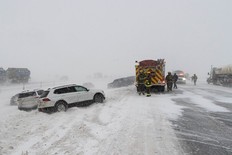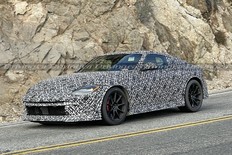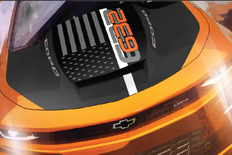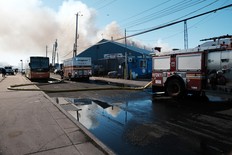Safety measures have been added in the area where seven-year-old Ukrainian refugee Maria Legenkovska was hit by a car last week. Why did a child have to die before something was done?

Article content
It took just two days after a seven-year-old Ukrainian refugee was killed by a car on her way to school last Tuesday morning for the city to show up and install some bollards to tame traffic at the corner of de Rouen and Parthenais Sts. By Thursday afternoon, black plastic poles with yellow stripes narrowed the passageway for cars transiting the school zone while widening the space for pedestrians preparing to cross the street.
Advertisement 2
Article content
This might have been an example of the city deserving a pat on the back for a swift response to a terrible tragedy — if only neighbourhood residents hadn’t been begging for such measures since 2015. Instead, the rapid reaction raises questions: What the heck took so long? And why did a child have to die before something was done?
There wasn’t a heart in Montreal that didn’t shatter into a million pieces when the news broke that the child struck in Tuesday morning’s hit and run had not only died, but that she was also a Ukrainian refugee who had arrived in Montreal just four months ago with her mother and two siblings.
Maria Legenkovska managed to escape Russian bombs, but she couldn’t make it safely across one of Montreal’s mean streets.
Advertisement 3
Article content
How utterly unfair. How cruel. But, more to the point, how enraging.
How could we have let this happen?
Legenkovska isn’t the first pedestrian to die in Montreal this year — she is the 19th, according to police. She isn’t even the first child: a two-year-old in a stroller was killed in Montreal North during the summer. But after a lot of head-shaking and hand-wringing, little has changed.
The seven-year-old Ukrainian isn’t even the first pedestrian fatality in the last month — she’s the fourth in Montreal and the seventh in the wider region. Those previous incidents, mostly involving seniors, raised eyebrows, but were little more than police blotter briefs — as if a spate of octogenarians being mowed down by vehicles is somehow par for the course.
Advertisement 4
Article content
Apparently the city needed a martyr to shake us from inertia and ineptitude.
There’s something different about the response to Legenkovska’s death. Whether due to her young age, public sympathy for the victims of the war in Ukraine or a sense of collective guilt that a child who fled the horrors of war died in our city, unbearable grief has boiled over into outrage.
A candlelight vigil was held for the girl Tuesday night, and during Friday morning’s rush hour residents marched down the street where Legenkovska was killed. Children holding yellow signs that read “halt road violence” were accompanied by police officers and Mayor Valérie Plante.
The concern of officials is no doubt genuine. But where were authorities earlier, when residents were warning this kind of calamity was bound to happen?
Advertisement 5
Article content
This isn’t the first time protesters have denounced unsafe streets in Ville-Marie borough, where Plante was a councillor before she was mayor and borough mayor. Back in the summer of 2019, neighbours rallied at the intersection of Hochelaga and d’Iberville Sts. where Roger-Michel Proulx was killed by a car on his way to the laundromat.
After Proulx died, a woman contacted me to share how she was struck and injured at the same intersection some months earlier, and had happened upon the aftermath of two other pedestrian collisions there. Since then, the city has extended the sidewalks on d’Iberville and painted the crosswalks red, reclaiming a few inches of a street used as a highway by many South Shore commuters heading to the Jacques-Cartier Bridge.
Advertisement 6
Article content
But it shouldn’t take a death to bring change. Across Montreal, parents have the same fears about their own children being struck down in school zones. People have the same worries about elderly parents, grandparents or neighbours becoming roadkill. And those trying to fix these dangerous situations express the same frustration about the snail’s pace of action.
Under Vision Zero, the international traffic safety strategy the city adopted in 2016, there are no accidents — only design flaws, risky conditions and bad attitudes to be remedied. But despite spending millions on urban redesign and crosswalk counters, lengthening crossing times and lowering speed limits, pedestrian casualties have climbed under this plan. Although the death toll dropped to 11 in 2021, it was 18 in 2020; 24 in 2019, a 10-year-old high; and 18 in 2018, a six-year record. So far in 2022, it’s 19. No improvement.
Advertisement 7
Article content
Why? Is it that there are more and bigger cars on the road than ever before? Is it that drivers are more aggressive, impatient and distracted? Most people don’t leave home in the morning intending to hit a pedestrian, but too many people turn into monsters behind the wheel. Maybe we all need to look in the mirror.
Are police too lax with enforcement? Now that an 87-year-old has been identified as the driver who rammed a baby in a stroller in Outremont last month, an incident Jewish groups initially feared was a hate crime, Montreal police are calling him merely “careless” and recommending his licence be revoked. It’s a miracle the child survived, but how is it not an obvious crime to hit a stroller and speed off? Prosecutors are studying the matter.
Sadly, even if a pedestrian dies, laying charges isn’t automatic. Collisions often don’t meet the bar for negligence or dangerous driving, so the coroner’s office later rules them avoidable accidents.
Is it taking too long to implement Vision Zero, in a vast city built to accommodate cars? Sure, reconstructing intersections takes time and money. All of Montreal can’t be altered at once. Some neighbourhoods have transformed radically and some welcome change more readily than others.
But if it’s so easy to put up a few bollards after a child dies, can’t we do it sooner to save lives?
Stay connected with us on social media platform for instant update click here to join our Twitter, & Facebook
We are now on Telegram. Click here to join our channel (@TechiUpdate) and stay updated with the latest Technology headlines.
For all the latest Automobiles News Click Here






